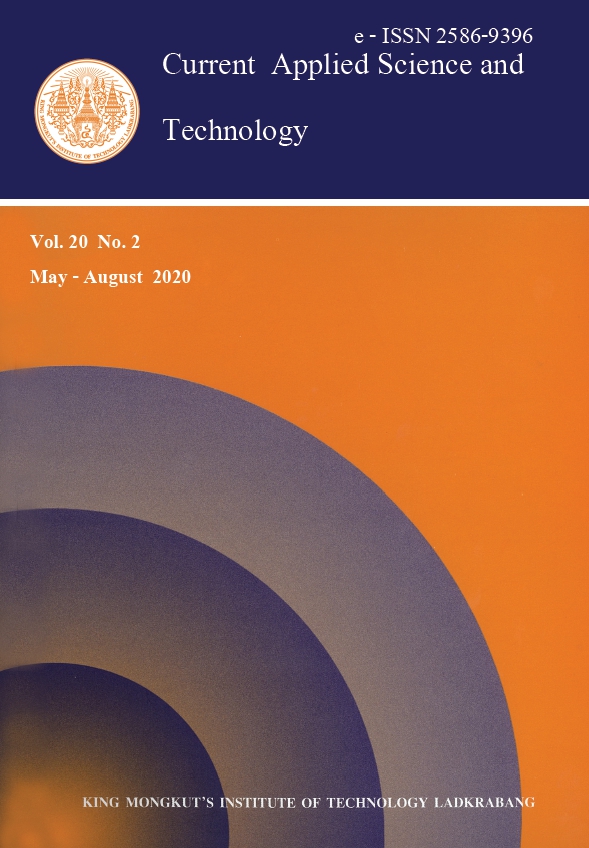Effects of Compressed Pressure and Speed of the Tandem Mill of Sugar Cane Milling on Milling Performance
Main Article Content
Abstract
Thailand is one of the sugar cane exporters in the world market and it offers a great contribution to the country’s national income. It is important for sugar factory to operate efficiently in milling against its competition to achieve a better performance. This study investigated the effects of pressure and speed of the tandem mill in sugar cane crushing based on extraction (EXT), power requirements (POW), specific energy consumption (SEC) and specific extraction per energy consumption (SEE) which are important parameters for sugar factory. Testing was performed using a small milling machine. The compressed pressure was adjusted by using the hydraulic pressure and the inverter was used to change the speed. After the test, the polarization meter was used to measure sugar in juice. It was found that when the compressed pressure increased, the EXT of the tandem mill had a tendency to increase from 2.7 to 6.0 x 106 N/m2 and slightly increased from pressure 6.0 to 10.0 x 106 N/m2. The POW of the tandem mill slightly increased. The SEC of the tandem mill tended to increase its tendency. The SEE slightly increased from pressure 2.7 to 6.0 x 106 N/m2 and severely decreased from pressure 6.0 to 10.0 x 106 N/m2. When the speed of the tandem mill increased, the EXT of the tandem mill had a tendency to decrease, the POW tended to increase their tendency, the SEC slightly decreased from 0.0844 m/s to 0.1 m/s and slightly increased from 0.1 m/s to 0.1631 m/s. The SEE slightly decreased. The maximum extraction (%) is earned at the intermediate compressed pressure and the lowest speed. The minimum power requirement (W) is earned at the lowest compressed pressure and the lowest speed. The minimum specific energy consumption (kWh/t) is earned at the lowest compressed pressure and the intermediate speed. The maximum specific extraction per energy consumption (%.t/kWh) is earned at the intermediate compressed pressure and the lowest speed. The results found in this study can benefit sugar factory to find performance and to make the decision on process operation.
Keywords: Tandem mill; extraction; sugar cane milling
*Corresponding author: Tel.: +66 43 00 9700 Fax: +66 43 36 2149
E-mail: somchai.chuan@gmail.com
Article Details
Copyright Transfer Statement
The copyright of this article is transferred to Current Applied Science and Technology journal with effect if and when the article is accepted for publication. The copyright transfer covers the exclusive right to reproduce and distribute the article, including reprints, translations, photographic reproductions, electronic form (offline, online) or any other reproductions of similar nature.
The author warrants that this contribution is original and that he/she has full power to make this grant. The author signs for and accepts responsibility for releasing this material on behalf of any and all co-authors.
Here is the link for download: Copyright transfer form.pdf
References
[2] Arjchariyaartong, W., 2006. The Competitiveness of the Sugar Industry in Thailand. Unpublished doctoral dissertation. University of Hohenheim, Stuttgart, Germany.
[3] Modesto, M. Ensinas, A.V. and Nebra, S.A., n.d. Sugar Cane Juice Extraction Systems Comparison-Mill Versus Diffuser. [online] Available at: https://www.abcm.org.br/anais/cobem/2005/PDF/COBEM2005-0836.pdf
[4] Food and Agriculture Organization of the United Nations, 1997. Proceedings of the Fiji/FAO 1997 Asia Pacific Sugar Conference. [online] Available at : http://www.fao.org /docrep/005/ x0513e/x0513e24.htm
[5] Office of The Sugar Cane and Sugar Board, 2017. Quality Report of Sugar Cane C.C.S in Year 2016/2017. Bangkok: Office of The Sugar Cane and Sugar Board.
[6] Atherton, P. G., 1954. Bagasse Compression Tests. Proceedings Queensland Society of Sugar Cane Technologists Twenty-first Conference, 235-240.
[7] Bullock, K. J., 1955. The Effect of Speed, Preparation and Compression Ratio on the Performance of the Experimental Sugar Mill in the University of Queensland. Proceedings Queensland Society of Sugar Cane Technologists Twenty-second Conference, 201-218.
[8] Bullock, K. J., 1957. Compression ratio and performance of the experimental sugar mill. Proceedings Queensland Society of Sugar Cane Technologists Twenty-fourth Conference, 43-62.
[9] Olaoye, J. O., 2011. Development of sugar juice extractor for small scale industries. Journal of Agriculture Technology, 7(4), 931-944.
[10] Olaoye, J. O., 2009. Partial mechanization of sugarcane juice extraction process. XXXIII CCIOSTA-CIGR V Conference 2009. [online] Available at : https://www.researchgate.net/ publication/272649200
[11] Hugot, E., 1986. Handbook of Cane Sugar Engineering. Third Edition. Netherlands: Elsevier Publishing Company.
[12] Oliverio, J.L. Avila, A.C.R.D. Faber, A.N. and Soares P.A. Juice Extraction Systems: Mills and Diffuser - The Brazilian Experience. [online] Available at: http://www.codistil.com.br/ index. php?option=com_docman&task= doc_view&gid=163&Itemid=40&lang=pt [Accessed: 15 February 2018].
[13] Adam, C. J. and Loughran, J. G., 2005. The effect of blanket thickness on extraction energy in sugarcane rolling mills: a finite element investigation, Biosystems Engineering, 92(2), 255-263.
[14] Lewinski, J. Grassmann, P. and Kallin, T., 2011. Operation of sugar mills with individual variable speed drive. Proceedings South Africa Sugar Cane Technologists Association, 84, 460-471.
[15] Lobo, P.C. Jaguaribe, E.F. Rodrigues, J. and Rocha, F.A.A., 2007. Economics of alternative sugar cane milling options. Applied thermal engineering, 27, 1405-1413.
[16] Wienese, A., 2003. Mill feeding: Back to basics. Proceedings South Africa Sugar Cane Technologists Association, 77, 369-377.
[17] Shinde, V.V., 2015. Weight reduction and analysis of sugar mill roller using FEA techniques, International journal of latest trends in engineering and technology, 5(1), 346-354.
[18] International Commission for Uniform Methods of Sugar Analysis, 1994. ICUMSA. Norwich, England: ICUMSA Publication Department.
[19] Backward elimination and stepwise regression. [online] Available at: https://www.coursehero.com/ file/16140622/ch63


